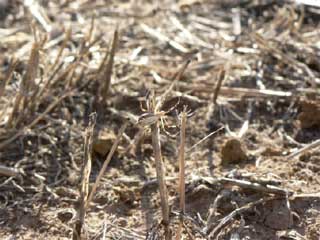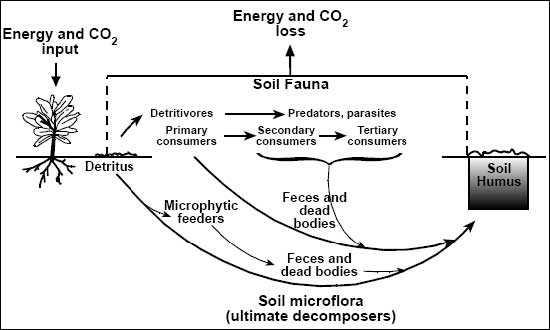Practical Note: Soil Organic Matter
Decomposition | Forms and Function | Management of Soil Organic Matter | Carbon Cycle
Download the PDF version of this document: Practical Note: Soil Organic Matter (PDF 284 KB)
To view the information PDF requires the use of a PDF reader. This can be installed for free from the Adobe website (external link).
An output of the ‘Soil Health for Sustainable and Productive Landscapes’ Project
| Soil organic matter (SOM) is made up of living plants and animals (roots, fungi, bacteria, macro fauna and micro fauna), plant litter, and all the degraded material from decomposing plant and animal material. SOM provides the energy and food stream into (and through) the soil. SOM is an essential component of soils because it provides energy for soil microbes, supports and stabilises soil structure, increases water retention, stores and supplies nutrients, builds diversity, enhances the soils resistance to disease, stores carbon from the atmosphere, and buffers chemical behaviour. |  A spider on the remains of a crop stalk after harvest |
The source of SOM
Plants are able to harvest energy from sunlight by making carbohydrates from carbon dioxide and water. This is photosynthesis and provides the energy for powering ecosystems. Plant (and animal) residues then become available for soil organisms to feed on, metabolise and produce new residues. These new residues then become the food source for yet more organisms – and so on. Figure 1 puts this into a diagrammatic form.

Figure 1. The pathway for the break down of plant matter (redrawn from Brady, 1990)
What controls SOM?
SOM is cycled through the soil by a diverse range of soil organisms. There are four distinct pools of organic matter including dissolved, particulate (consisting of fresh residues and partly decomposed material), humus (stabilised SOM resistant to further decomposition) and inert (not biologically decomposable). The total amount of SOM in the soil is a balance between organic matter added by plant and animal materials, and the amount lost through decomposition.
Practical Note: Soil Organic Matter
An output of the ‘Soil Health for Sustainable and Productive Landscapes’ Project
How much is enough?
There is no standard figure for enough SOM in any given soil. The texture of your soil plays a role in how much organic matter your soil can produce and house. Soil biology also plays a very important role in organic matter stores and decomposition.
The assessment of SOM
The common way of scientifically assessing SOM is to digest the organic matter in a soil sample and measure the level of soil organic carbon (SOC). Then this can be converted to a percentage SOM based on our knowledge that carbon comprises between 50 % - 58 % of SOM.
% SOM = % SOC x 1.72
Unfortunately measuring SOC is a time consuming procedure; worthwhile sure, but we still need field methods of gaining a general appreciation of SOM. Visual assessment of litter, colour and smell can provide some initial indicators of likely organic matter levels. Other indicators are:
- Root exploration rates
- Structural characteristics
Improving organic matter in your soil
There are many management practices you can do to improve SOM on your property. Practices that may increase soil organic matter include:
- Reducing or eliminating tillage
- Maintaining vegetative cover
- Protect soil from fire
- Stubble retention
- Adding manures or other organic matter sources
- Restrict grazing
- Control insects and rodents
References
Brady NC (1990) ‘The nature and properties of soils'. (MacMillan Publishing Company: New York)
Lawrence D (Ed) (2007) ‘Assessing soil health. A guide to assessing soil health on your farm’. Healthy Soils for Sustainable Farms initiative – Queensland Department of Primary Industries & Fisheries, NSW Department of Primary Industries.
United States Department of Agriculture (1996) ‘Soil Quality Indicators: Organic Matter’. Soil Quality Institute, National Resources and Conservation Service, USDA - http://soils.usda.gov/sqi/index.html


